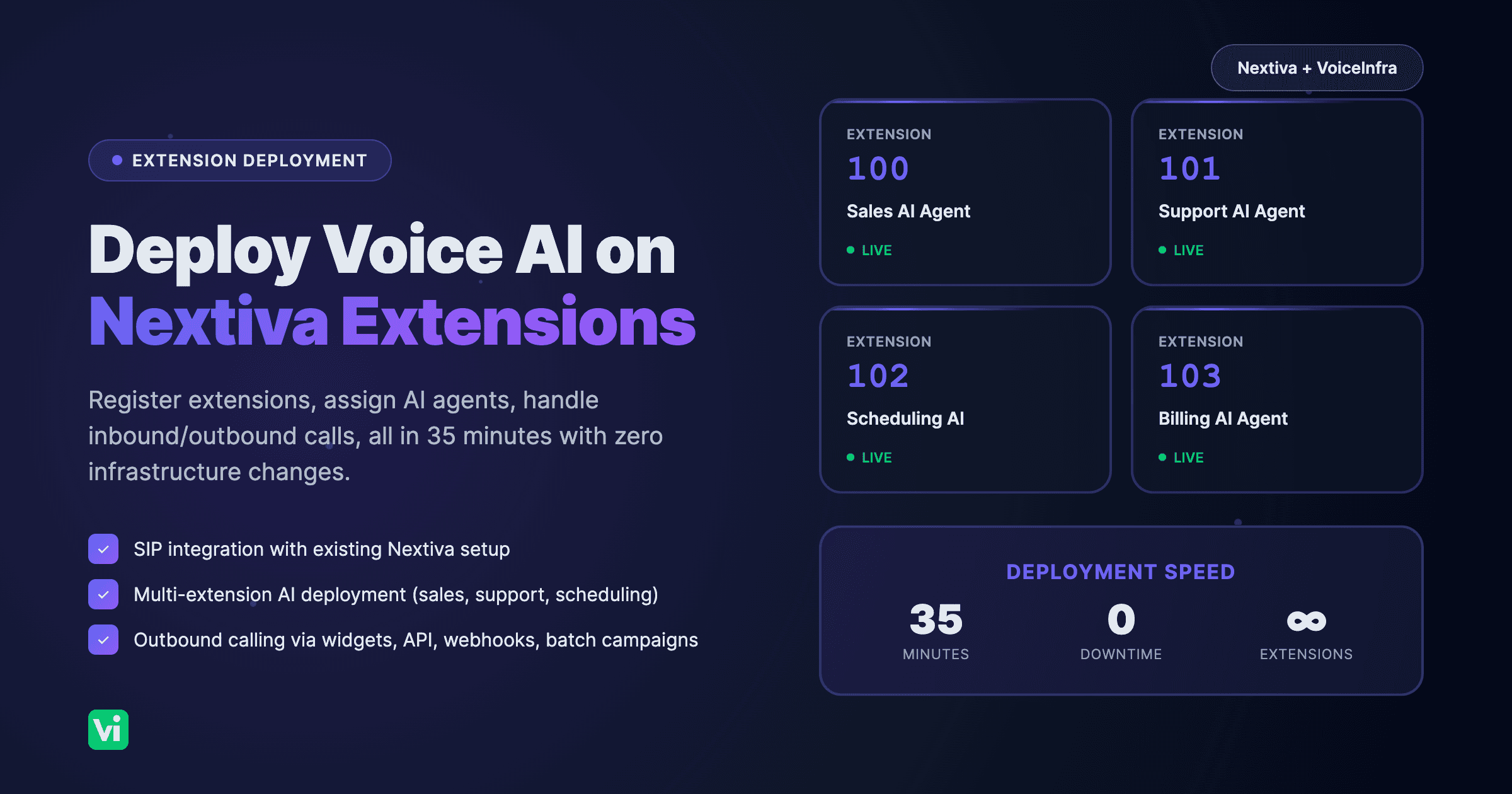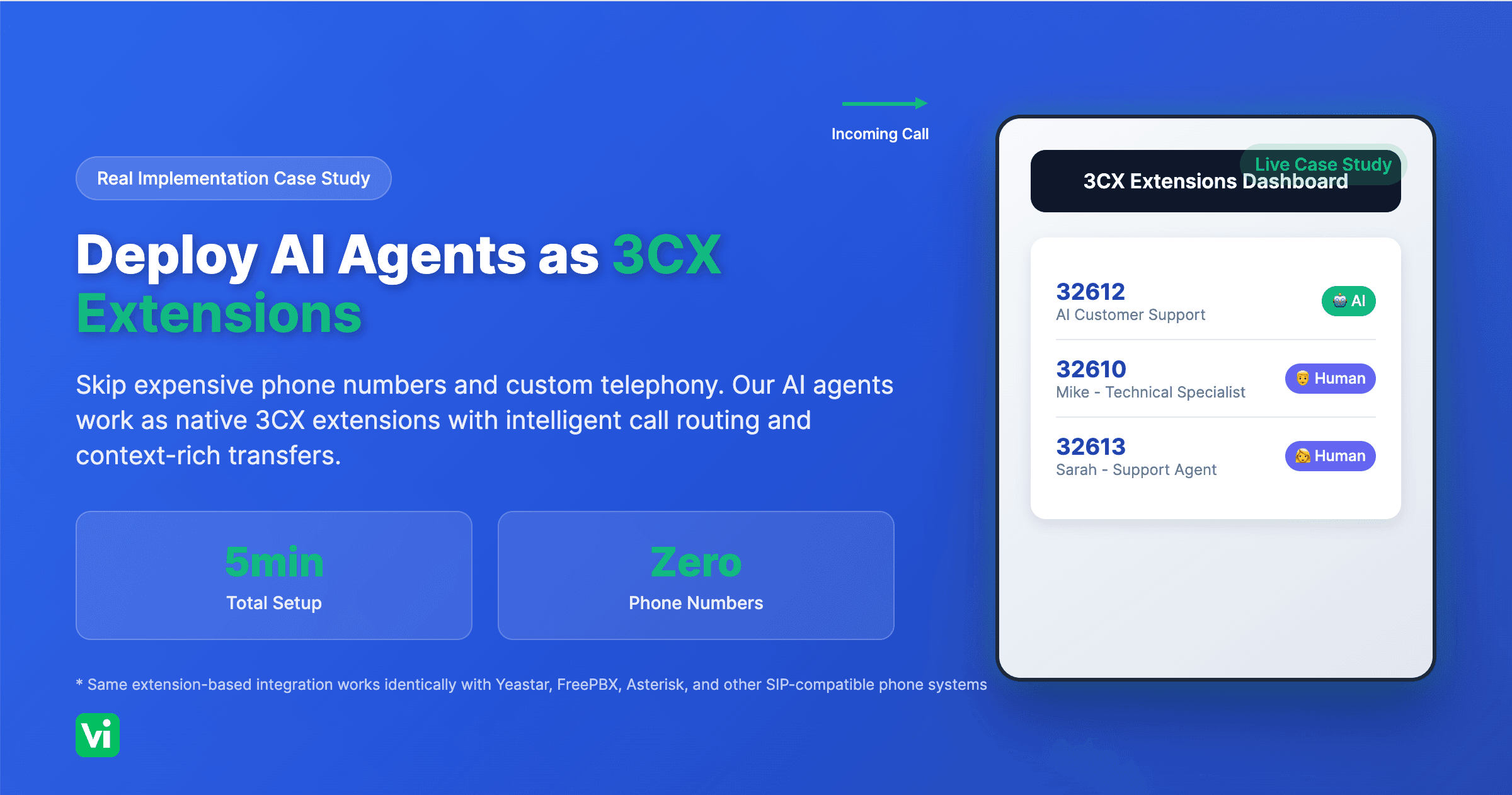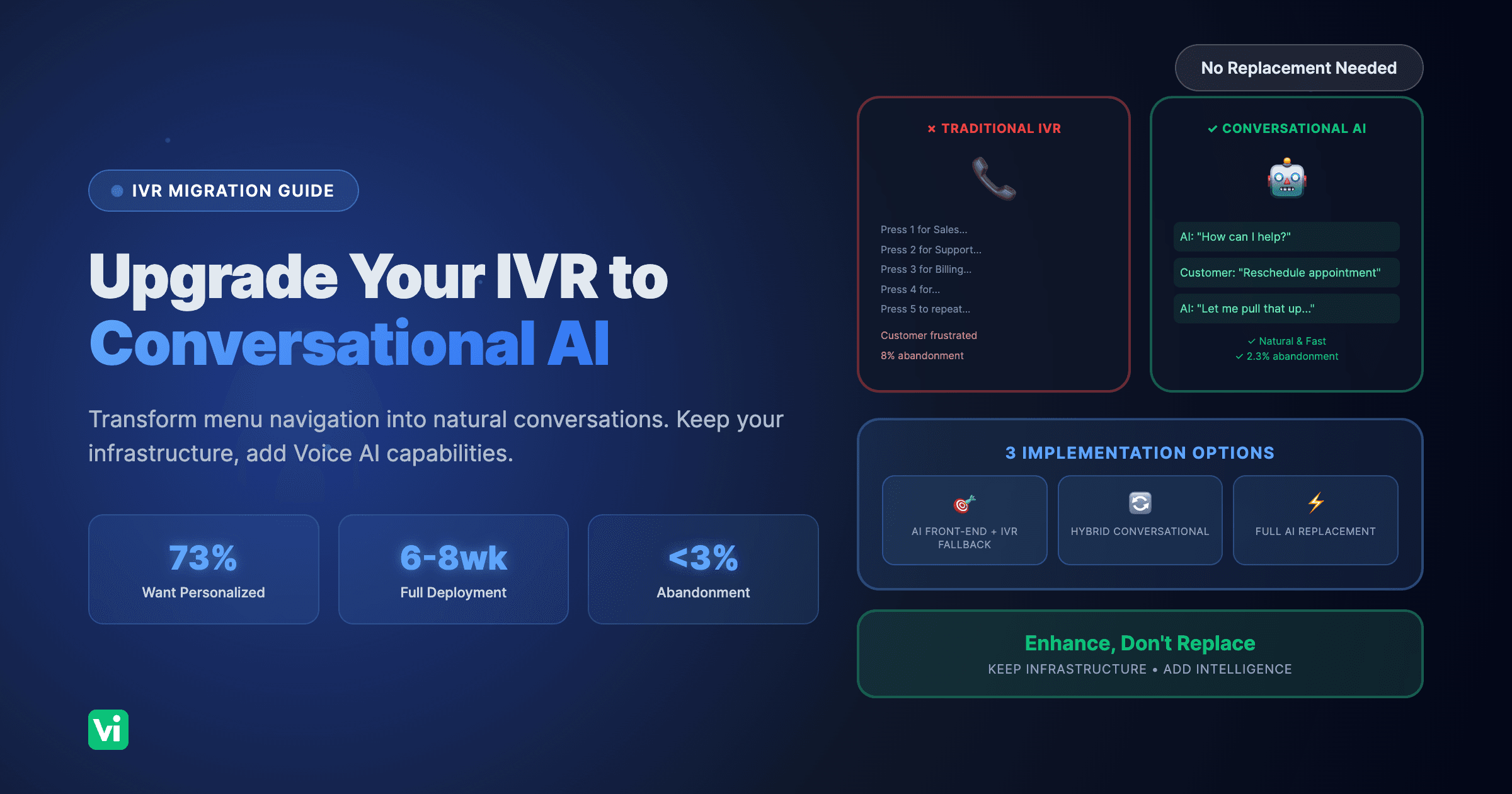Your enterprise spent $50,000+ on a robust PBX system. 3CX, Yeastar, FusionPBX, FreeSWITCH, Nextiva, or Vicidial; whatever you choose; it’s the backbone of your communication infrastructure.
Now you want to add AI voice agents. Every vendor tells you the same thing:
"Buy phone numbers from Twilio. Configure them in Twilio. Then configure them again in our system. Manage two places. Oh, and replace your PBX eventually."
One enterprise customer asked us point-blank:
"Are you guys going to make me put a number I bought from Twilio that I configure on my end, into your system again? I don't like duplicating configurations and managing multiple systems."
Our answer changed everything:
"No. Just configure the extension you already assigned the number to. That's it."
Their response: "We really love this approach."
This is extension-based AI integration. And it's something no other AI voice platform has figured out.
The Problem: Number Duplication Hell
The Traditional AI Voice Integration Nightmare
Here's how every other AI voice platform works:
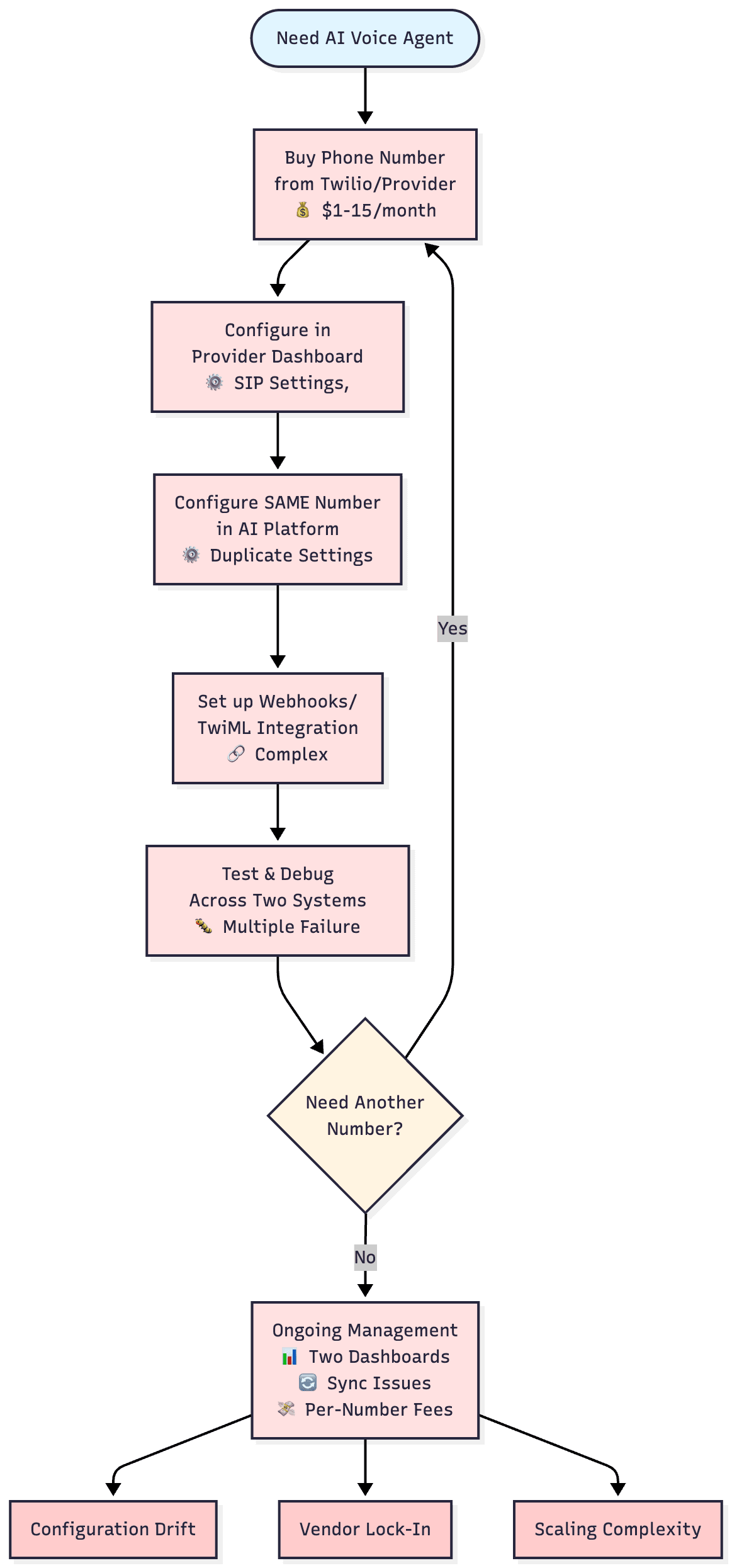
Traditional AI Voice Telephony Integration Nightmare
The painful multi-step process of traditional AI voice integration with duplicate configurations
For enterprises with 10, 50, or 100+ numbers? This becomes a configuration nightmare.
For businesses with existing PBX investments? This feels like being forced to abandon infrastructure that works perfectly.
For IT directors managing complex telephony systems? This creates unnecessary duplication, security concerns, and operational overhead.
The Hidden Costs of Traditional Integration
Configuration Overhead:
Duplicate settings across multiple platforms
Synchronization headaches when changes are needed
Multiple points of failure in call routing
Increased troubleshooting complexity
Vendor Lock-In:
Forced to use specific phone number providers
Limited flexibility in carrier selection
Dependency on third-party infrastructure
Migration difficulties if you want to switch
Infrastructure Waste:
Existing PBX capabilities are underutilized
Redundant SIP trunk configurations
Additional monthly costs for new numbers
Complexity that doesn't add value
The Solution: Extension-Based AI Integration
How VoiceInfra Does It Differently
Instead of forcing you to buy new numbers and duplicate configurations, we register TO your existing PBX as an extension.
Here's the complete process:
Step 1: Identify an available extension on your PBX (e.g., ext. 101)
Step 2: Provide extension credentials to VoiceInfra
Step 3: Our system registers as that extension
Step 4: Assign an AI agent to the extension
Step 5: Done. The AI is live.Time required: 5-10 minutes.
New phone numbers needed: Zero.
Configuration duplication: None.
PBX changes required: Minimal (just like adding a new desk phone).
How Extension Registration Works
The simple process:
You provide extension credentials - Extension number, domain, username, password, and proxy details from your PBX
VoiceInfra registers as that extension - Our platform connects to your PBX just like any SIP endpoint would
AI agent is assigned - Your configured AI agent is now available on that extension
Calls flow naturally - The extension handles calls exactly like any other endpoint on your PBX
From your perspective: You added an extension to your PBX. That extension happens to be an AI agent.
From your PBX's perspective: It's just another registered endpoint, like a desk phone or softphone.
System-Agnostic: Works With ANY PBX
We've successfully integrated with:
✅ 3CX - The most popular SMB PBX platform
✅ Yeastar - Growing rapidly in enterprise deployments
✅ FusionPBX - Open-source flexibility favorite
✅ FreeSWITCH - Telecom-grade carrier infrastructure
✅ Nextiva - Leading cloud PBX provider
✅ Vicidial - Contact center industry standard
✅ Proprietary PBX systems - Custom enterprise solutions
The only requirement: Your PBX must support SIP extensions (which virtually all modern systems do).
Real customer story: An enterprise client set up our AI agents on their call center's three different PBX systems, 3CX, FusionPBX, and a proprietary PBX, using our platform. They used the same simple extension registration process for all three, with no special configurations or system-specific integrations.
Why Enterprises Love Extension-Based Integration
1. Zero Configuration Duplication
Traditional approach:
Configure number in Twilio: 15 minutes
Configure the same number in the AI platform: 10 minutes
Troubleshoot synchronization issues: 30+ minutes
Total per number: 55+ minutes
Extension approach:
Configure extension in VoiceInfra: 5 minutes
Total per number: 5 minutes
For 20 numbers: Save 16+ hours of configuration time.
2. Infrastructure Preservation
Your existing PBX investment is protected:
No need to replace working systems
Leverage existing call routing logic
Maintain current security configurations
Keep established disaster recovery procedures
One IT director told us:
"We spent three years perfecting our 3CX configuration. Every other AI vendor wanted us to start over. You let us keep everything and just add intelligence. That's the difference between a vendor and a partner."
3. Operational Simplicity
Extension management is familiar:
IT teams already know how to manage extensions
Standard PBX tools show AI agent status
Call logs appear in existing reporting systems
Troubleshooting uses existing procedures
No new systems to learn. No new dashboards to monitor. No new processes to document.
4. Flexible Deployment Models
Because AI agents are just extensions, you can:
Dedicated AI Extensions:
Extension 101: Sales AI agent
Extension 102: Support AI agent
Extension 103: After-hours AI agent
Overflow Routing:
Route overflow calls to the AI extension during peak times
Maintain a human-first approach with AI backup
Time-Based Routing:
Forward the main line to the AI extension after business hours
Weekend and holiday coverage without staffing costs
Department-Specific:
Each department gets a dedicated AI extension
Customized AI behavior per department
Separate reporting and analytics
5. Security and Compliance
Extension-based integration maintains your security posture:
Firewall Rules: No changes required, AI registers outbound to your PBX
Network Segmentation: AI extension lives in your existing voice VLAN
Audit Trails: Extension activity logged in your PBX, like any other endpoint
Access Control: Managed through existing PBX user permissions
Compliance: HIPAA, PCI-DSS, and SOC 2 compliance are maintained through your infrastructure
Comparison: Extension Registration vs. Traditional Integration
Real-World Use Cases
Use Case 1: Multi-Location Enterprise
Challenge: 15 office locations, each with different PBX systems (mix of 3CX, Yeastar, and legacy systems)
Traditional Solution: Would require 15 different integration approaches, custom configurations per location, and months of deployment time
Extension Solution:
Same extension registration process for all locations
Each location adds AI as an extension 200
Deployed across all 15 locations in one week
Centralized AI management, distributed execution
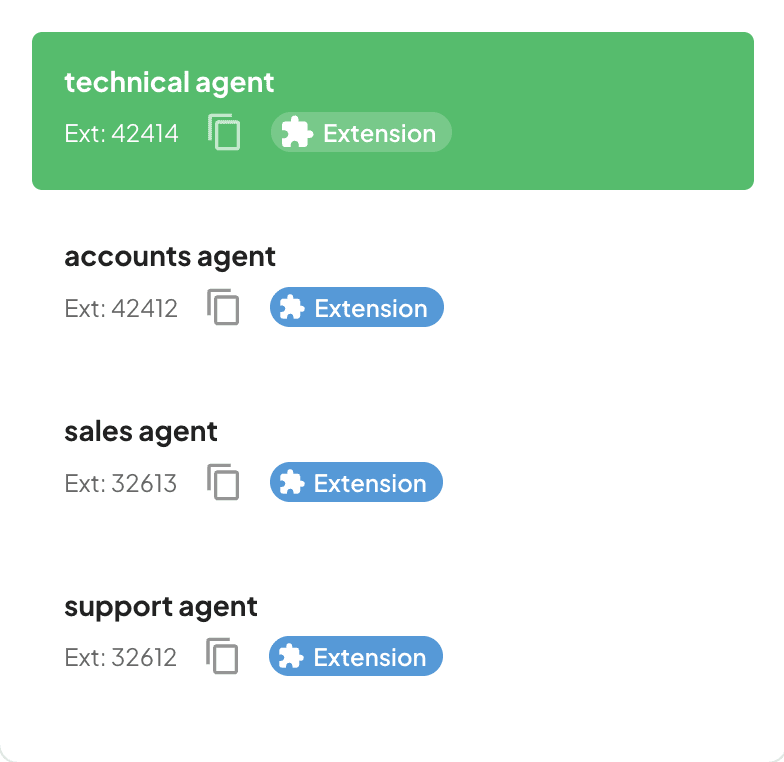
multiple extensions registered
Dashboard showing multiple extensions registered across different locations.
Result: 90% faster deployment, zero infrastructure changes, consistent AI experience across all locations
Use Case 2: Contact Center Overflow
Challenge: 50-seat contact center experiences 2-3 hour daily peak periods with 20%+ call abandonment
Traditional Solution: Hire additional agents (expensive, training overhead) or accept lost calls
Extension Solution:
Configure AI agents as extensions 301-310
Route overflow calls to AI extensions during peaks
AI handles routine inquiries, escalates complex issues
Human agents focus on high-value interactions
Result: Call abandonment reduced to <5%, customer satisfaction improved 23%, no additional hiring needed
Use Case 3: After-Hours Coverage
Challenge: 35% of inbound calls happen outside business hours, going to voicemail, and creating a next-day backlog
Traditional Solution: Hire night shift staff or accept lost opportunities
Extension Solution:
Configure the AI agent as extension 999
Time-based routing: forward main line to ext. 999 after 5 PM
AI qualifies leads, books appointments, and handles FAQs
Urgent issues escalated to on-call staff with full context
Result: 24/7 coverage, 40% of after-hours calls fully resolved by AI, 60% qualified and scheduled for next-day follow-up
Use Case 4: Department-Specific AI
Challenge: Sales, support, and billing departments need different AI behaviors and knowledge bases
Traditional Solution: Complex routing logic, multiple phone numbers, and difficult to manage
Extension Solution:
Extension 101: Sales AI (product knowledge, lead qualification)
Extension 102: Support AI (troubleshooting, ticket creation)
Extension 103: Billing AI (payment processing, account inquiries)
Each extension has a customized AI agent with department-specific training
Result: Specialized AI per department, simple management, clear reporting per function
Step-by-Step: Adding AI to Your PBX in 10 Minutes
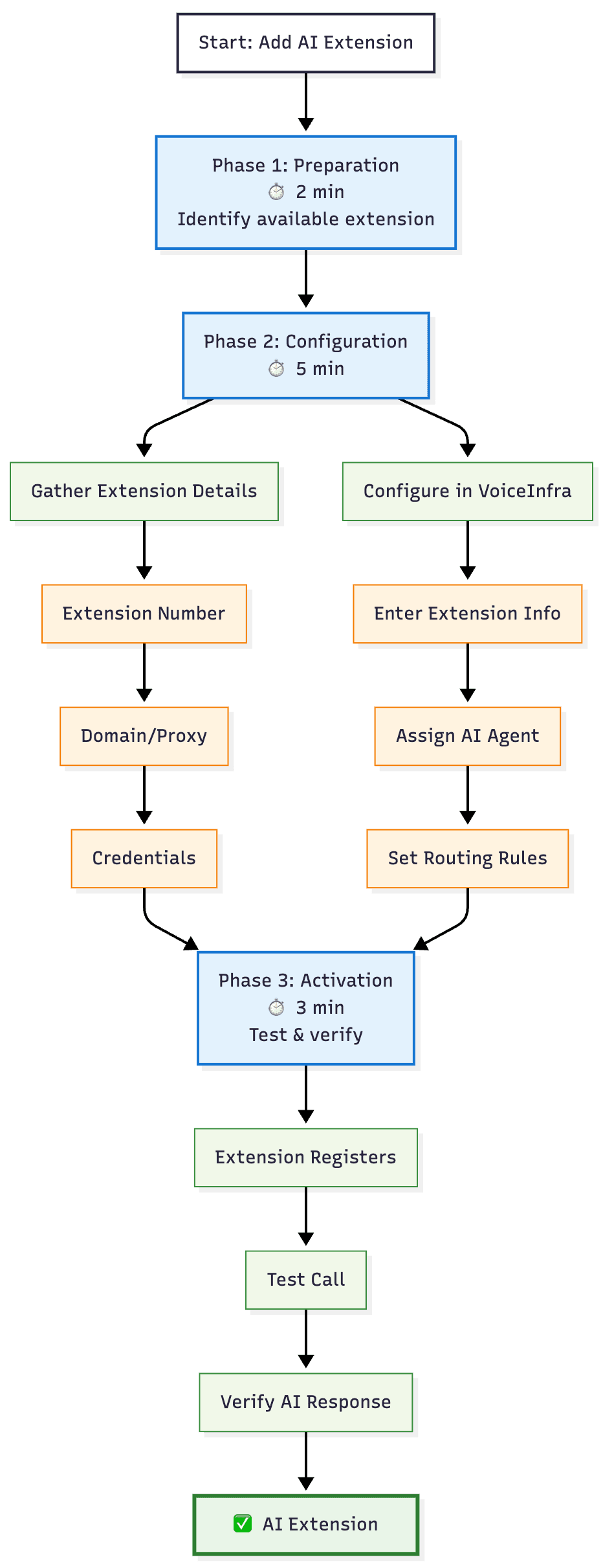
simple 3-phase extension registration process
VoiceInfra simple 3-phase extension registration process
Phase 1: Preparation (2 minutes)
Identify an available extension on your PBX:
Choose an unused extension number (e.g., 101, 200, 999)
Verify it's not assigned to any physical device
Note your PBX domain/proxy address
No PBX changes needed yet; just information gathering.
Phase 2: Configuration (5 minutes)
In your VoiceInfra dashboard:
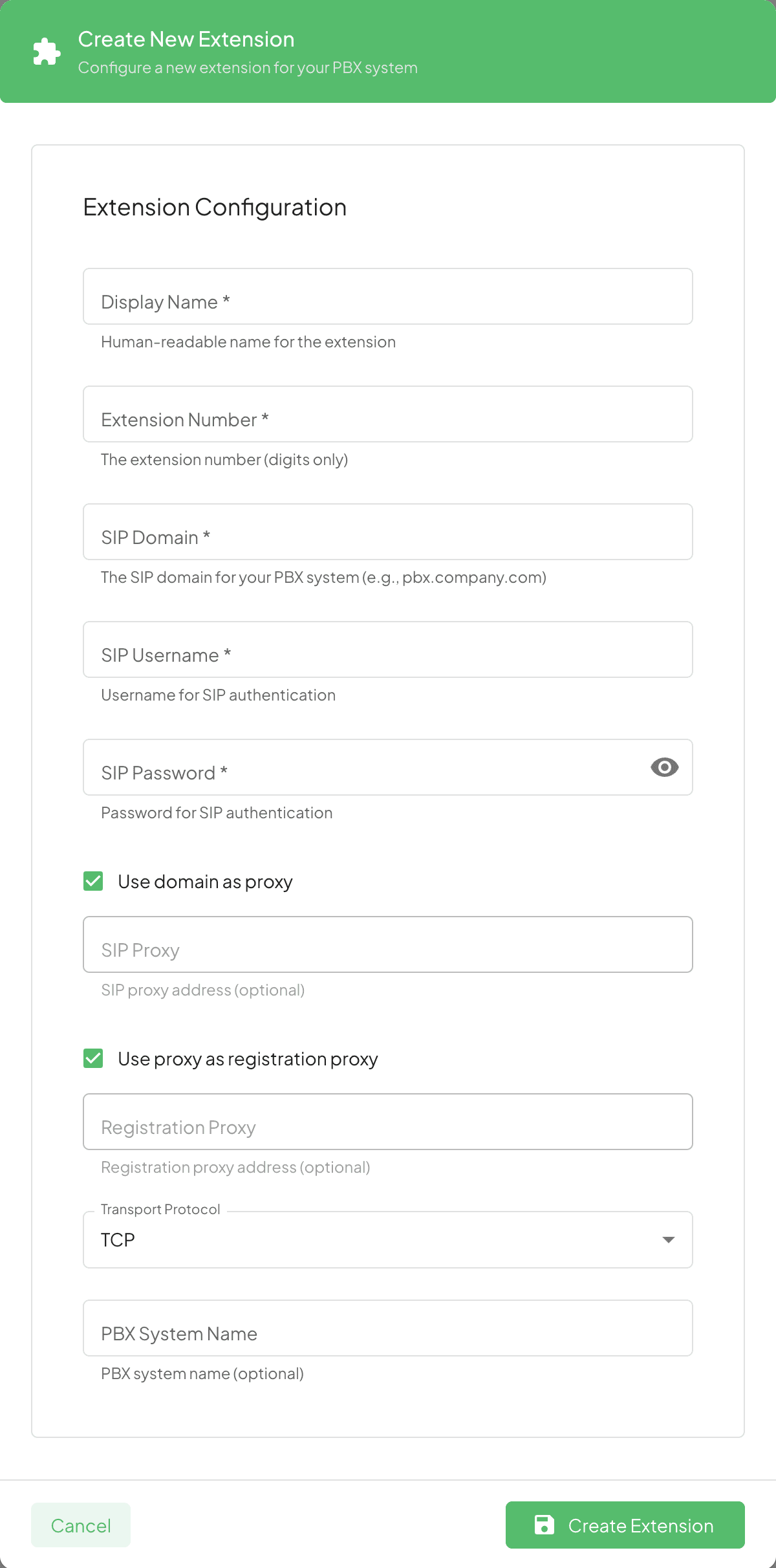
register-extension-popup
Extension configuration form with SIP credentials fields
Navigate to Phone Numbers → Add Extension
Enter extension details:
Extension Number: The extension you identified (e.g., 101)
Domain: Your PBX domain (e.g., pbx.yourcompany.com)
Username: SIP username for the extension
Password: SIP password for the extension
Proxy: SIP proxy address (usually the same as the domain)
Transport: TCP or UDP (match your PBX configuration)
Friendly Name: Descriptive name (e.g., "Sales AI Agent")
Assign an AI agent to the extension
Configure routing preferences (direct answer, transfer rules, escalation)
Click "Create Extension"
Phase 3: Activation (3 minutes)
Automatic registration:
VoiceInfra's system registers with your PBX as the specified extension
Extension appears in your PBX's registered endpoints list
Status shows as "Registered" in both systems
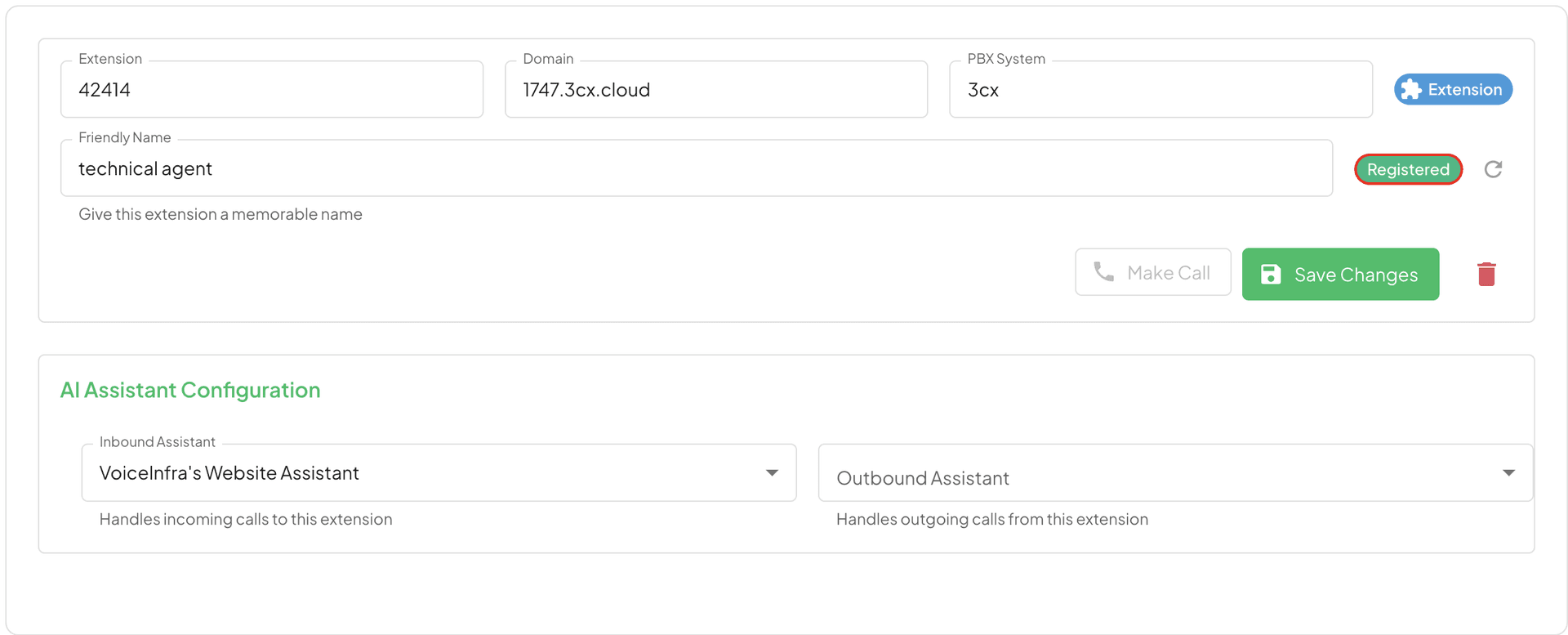
Extension status showing -Registered- with a green indicator and active connection details
Extension status showing "Registered" with a green indicator and active connection details
Test the integration:
Call the extension from another phone on your PBX
AI agent answers and engages in conversation
Test escalation by requesting to speak with a human
Verify call logs appear in your PBX reporting
That's it. Your AI extension is live and handling calls.
Advanced Capabilities: Beyond Basic Extensions
Intelligent Call Routing
Extension-based AI enables sophisticated routing:
Skills-Based Routing:
Extension 101: Product questions → Sales AI
Extension 102: Technical issues → Support AI
Extension 103: Billing inquiries → Finance AI
Priority Routing:
VIP customers → Direct to human agents
Routine inquiries → AI extension first
Emergency keywords → Immediate escalation
Load Balancing:
Monitor human agent availability
Route to AI extensions during high volume
Seamless handoff when agents become available
Real-Time Integrations
Because AI extensions live in your PBX ecosystem:
CRM Integration:
Caller ID lookup in Salesforce, HubSpot, Zoho
Automatic note creation with conversation summary
Lead scoring and qualification
Follow-up task creation
Business Systems:
Calendar integration for appointment booking
Inventory systems for product availability
Order management for status updates
Payment processing for billing inquiries
Workflow Automation:
Ticket creation in Zendesk, Jira, ServiceNow
Email notifications to relevant teams
SMS confirmations to customers
Slack/Teams alerts for urgent issues
Analytics and Reporting
Extension-based deployment provides unified analytics:
PBX-Level Reporting:
AI extension call volume in standard PBX reports
Integration with existing call analytics tools
Historical data alongside human agent metrics
Familiar reporting formats and dashboards
AI-Specific Insights:
Conversation sentiment analysis
Intent recognition accuracy
Escalation rate and reasons
Resolution rate by topic
Customer satisfaction scores
Combined Intelligence:
Compare AI vs. human agent performance
Identify optimization opportunities
Track ROI and efficiency gains
Forecast staffing needs
Frequently Asked Questions
Can AI extensions really work with my specific PBX system?
Yes. If your PBX supports SIP extensions (which virtually all modern systems do), VoiceInfra can register as an extension. We've successfully integrated with 3CX, Yeastar, FusionPBX, FreeSWITCH, Nextiva, Vicidial, Avaya, Cisco, and numerous proprietary enterprise PBX systems. The only requirement is standard SIP protocol support.
Do I need to buy new phone numbers to use AI voice agents?
No. That's the entire point of extension-based integration. You use your existing phone numbers and existing PBX infrastructure. The AI agent registers as an extension on your PBX, just like a desk phone or softphone. No new numbers, no new carriers, no duplication.
How is this different from SIP trunk integration?
Traditional SIP trunk integration requires YOU to configure a trunk FROM your PBX TO the AI platform. Extension registration reverses this; WE register TO your PBX as an endpoint. This is simpler, more secure (outbound registration only), and leverages your existing extension management processes.
What happens if the AI can't handle a call?
;The AI seamlessly transfers the call to appropriate human agents with complete conversation context. The person receiving the transfer gets the full conversation history, customer details, and the specific reason for escalation. Your PBX handles the transfer using standard call transfer mechanisms, no special configuration is needed.
Can I use the same AI agent across multiple extensions?
Absolutely. You can assign the same AI agent to multiple extensions across different locations, departments, or PBX systems. Or you can create specialized AI agents for various extensions. Complete flexibility based on your needs.
How do I monitor AI extension status and performance?
AI extensions appear in your PBX's standard monitoring tools as registered endpoints. You can see registration status, call activity, and basic metrics in your existing PBX dashboard. For detailed AI-specific analytics (conversation quality, sentiment, resolution rates), use the VoiceInfra dashboard.
What if I want to remove the AI extension?
Simply delete the extension configuration in VoiceInfra. The extension unregisters from your PBX automatically. You can then reassign that extension number to another device or AI agent. No residual configuration, no cleanup needed.
Does this work for both inbound and outbound calls?
Yes. AI extensions can receive inbound calls (when someone dials the extension or calls are routed to it) and make outbound calls (using your PBX's outbound routing rules). The AI agent behaves like any other extension on your system.
How secure is extension-based integration?
Very secure. The AI extension registers TO your PBX (outbound connection from our infrastructure), so no inbound firewall rules are needed. All communication uses encrypted SIP/TLS. The extension lives within your existing network security policies. You maintain complete control through your PBX's access controls and security settings.
Can I start with one extension and expand later?
Absolutely. Most customers start with a single AI extension for after-hours coverage or overflow handling. Once they see the value, they expand to multiple extensions for different departments, locations, or use cases. There's no minimum commitment; scale at your own pace.
The Future of Enterprise Telephony: Intelligence Without Replacement
The businesses that thrive in 2025 and beyond aren't ripping out working infrastructure; they're enhancing it with intelligence.
Your PBX system doesn't need replacement. It needs an AI extension.
Extension-based integration represents a fundamental shift in how enterprises adopt AI voice technology:
From: "Replace your phone system to get AI" To: "Add an extension to get AI"
From: "Buy new numbers and duplicate configurations" To: "Use your existing infrastructure"
From: "Vendor lock-in and forced migrations" To: "System-agnostic flexibility"
From: "Months of deployment and disruption" To: "Minutes of configuration and immediate value"
Why Extension-Based Integration Matters
For IT Directors:
Protect existing infrastructure investments
Leverage familiar extension management processes
Maintain security and compliance posture
Reduce operational complexity
For CFOs:
Eliminate unnecessary phone number costs
Avoid expensive system replacements
Scale AI adoption incrementally
Achieve faster ROI with lower risk
For Operations Leaders:
Deploy AI in minutes, not months
Maintain business continuity during rollout
Flexible deployment models (overflow, after-hours, dedicated)
Unified reporting and analytics
For CIOs:
System-agnostic approach prevents vendor lock-in
Standards-based integration ensures future compatibility
Gradual adoption reduces organizational change management
Proven across diverse PBX platforms
Ready to Add AI to Your PBX?
Stop duplicating configurations. Stop buying unnecessary phone numbers. Stop replacing working infrastructure.
Start with an extension.
Whether you're running 3CX, Yeastar, FusionPBX, FreeSWITCH, Nextiva, Vicidial, or any other SIP-compatible PBX, you can have an AI voice agent live on your system in under 10 minutes.
No infrastructure changes. No number duplication. No complexity.
Just intelligent automation that works with what you already have.
Get started today:https://voiceinfra.ai/
VoiceInfra's extension-based AI integration works with 3CX, Yeastar, FusionPBX, FreeSWITCH, Nextiva, Vicidial, Avaya, Cisco, and any SIP-compatible PBX system. Add AI voice agents to your existing infrastructure in minutes without buying new phone numbers, duplicating configurations, or replacing working systems. The only AI voice platform built for enterprise telephony reality.

